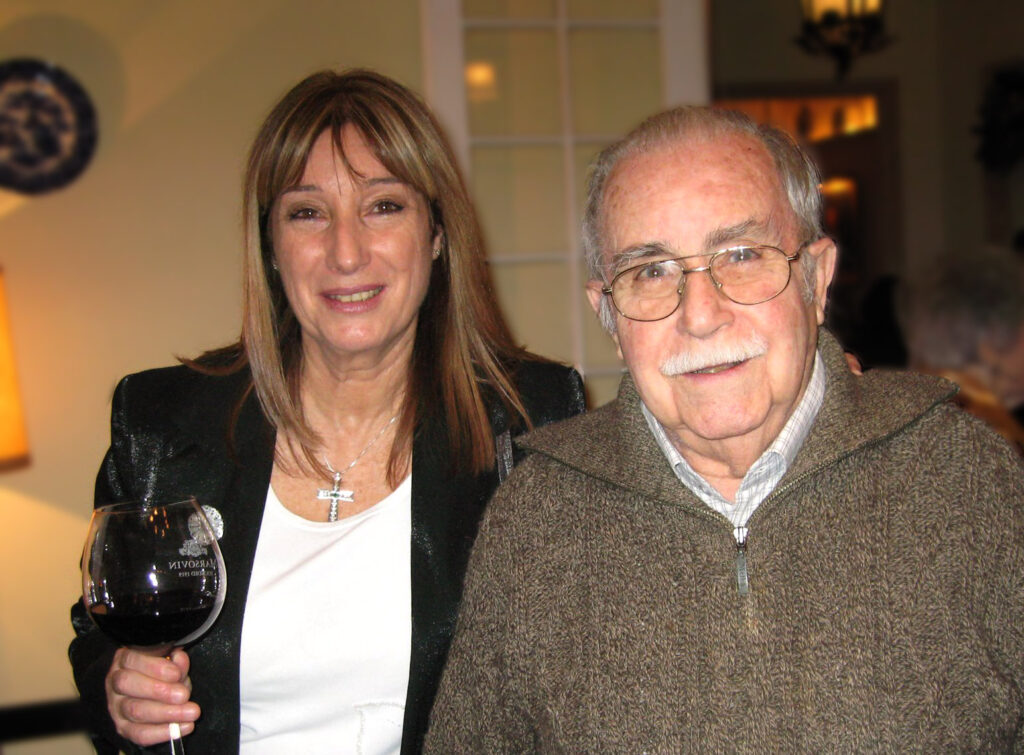

Lewis Wirth was born in Valletta on 4th September, 1923. During the WW2 lived for some time in Rabat. After the war settled in their summer residence in Balutta Bay, Sliema. He attended the School of Art from when he was fifteen, as his self-portrait drawing verifies. He attended during the war since it was the only institution that remained open. His tutors were Emvin Cremona, Vincent Apap, and his class included his future wife Helen Cavarra, besides Madeleine Asphar.
Vincent Apap sculptured a bust of Helen which was a prized possession. Also the gifts given to him by Emvin Cremona for their wedding in 195 of ‘The bathers’ an early work. Their friendship carried on till I got married and was also fortunate to be given a pen and ink drawing of his Bishop collections as a wedding gift in 1982. My parents also bought a beautiful mixed media of what looks like St Catherine de Ricci who based her conversion following St Catherine of Sienna, another early work. This friendship carried on until his passing away when my father wrote a poem dedicated to him. He was also instrumental in introducing and encouraging George Fenech to the School of Art, who was apprehensive to go. Today he is one of the most recognized artists of the modern era. I was witness to their close relationship as my father always used to tell me to go to Mellieha to meet my friend. I had no idea he was George Fenech, the accomplished artist!
During this time at the School of Art they both achieved the highest grades. They worked on large murals under Emvin with their own designs and designed some of their award certificates.
Since his family did not encourage him to carry on as an artist, my father was employed as an engraver with the family business of Francis Meli in Valletta where his father worked. He did not want to carry on working as he wanted to be an artist. His family refused to send him aboard so he was employed at the Barclays Bank DCO. This is where his adventure started.
After the war he got married and was sent to Tripoli, Libya, with other Maltese, to start a branch there. He married in 1952 and, still full of enthusiasm to carry on with his painting, he entered into this new Arab culture where he bloomed and made some of his best works. All of this can be seen in the book The Life and Work of Lewis Wirth & Helen Cavarra: Their Creative Partnership, by author John Paul Cassar. He brought up similarities between their culture and our culture. This can easily be seen in his work Jesus as Shepherd, which was taken from a sketch of an Arab carrying a lamb. He missed Malta and related some paintings to his memories of it, for example, the bastions and boats.
After eighteen years in Tripoli they returned to Malta in 1969 at the time of the Libyan revolution which happened after years of it being an Italian colony under King Idris. I was born in 1954 and was already sent to Malta at the age of eleven to carry on with my education at the Convent of the Sacred as a termly boarder. We came back because boarding schools stopped in 1969 and it was just a coincidence that Tripoli was taken over by a military coup in that year.
Returning to Malta was another turning point for him. He rediscovered Malta and went around the country like a tourist, sketching and taking colour notes to then go home and paint the scenes of Malta and Gozo. He used different media, mainly watercolors, but also used oils, scraper boards, charcoal, pen and ink, pastels, collages, with a great dexterity. He excelled in his ink drawings and many pencil drawings of Maltese scenes and his family. He also has abstracts, caricatures, war scenes, drawings for stamps and more, which shows his versatility.
During their time back in Malta they were part of the Natural History Society with Guido Lanfranco and his brother. They scouted the Maltese countryside and my mother Helen was capable of painting a collection of over 380 watercolors of Maltese flora with botanical accuracy. These paintings will be published in a book in the near future as it is in the process of being updated by Jeffrey Sciberras, a botanist with Nature Trust. Some names researched by my mother have now changed since the 1970s. Some of which were also painted by my father. They used to plant them in their own garden to keep them fresh until they painted them.
Seeing my parents constantly painting influenced my interest in art. I was his best critic and would tell him if there was no focal point. Although I worked in Accounts and took various Os and two A levels, I was one of the few in those days that took pottery as an O level at school and A level under Gabriel Caruana. This led to a summer scholarship in Perugia at the Academia di Belle Arti, since I also had an A level in Italian. I would have stayed longer, but had to come back to carry on with my job in Accounts. Today I have my own ceramic studio and give ceramic classes. Since my father passed away I started painting again as he always told me it was a pity I do not paint. Never too late to listen to your parents.
Both my parents’ painted most of their lives. They met at the School of Art and carried on achieving that high standard they received in those days. Their dedication and love of art is well illustrated in the book by the author.
Theirs is a love story through art.
Mariz Cassar Wirth Cavarra

